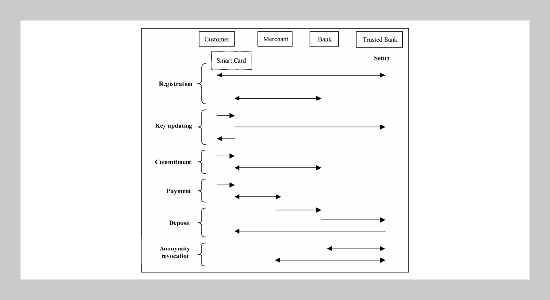REFERENCES
- [1] Herberg, Amir, “Micropayment,” Payment Technologies for E-Commerce, Kou, Weidong Ed., New York: Springer, pp. 245�282 (1998).
- [2] Anand, R. Sai and Madhavan, C. E. Veni, “An Online, Transferable E-Cash Payment System,” Advance in Cryptology � INDOCRYPT 2000, LNCS, Vol. 1977, New York: Springer-Verlag, pp. 93�103 (2000).
- [3] Brands, Stefan, “Untraceable Off-Line Cash in Wallet with Observers,” Advances in Cryptology � CRYPTO ’93, LNCS, Vol. 773, New York: Springer-Verlag, pp. 302�318 (1993).
- [4] Chan, Agnes, Frankel, Yair, and Tsiounis, Yiannis, “Easy Come � Easy Go Divisible Cash,” Advances in Cryptology � EUROCRYPT ’98, LNCS, Vol. 1403, New York: Springer-Verlag, pp. 561�575 (1998).
- [5] Frankel, Yair, Tsiounis, Yiannis and Yung, Moti, “Indirect Discourse Proofs: Achieving Efficient Fair Off-Line E-Cash System,” Advance in Cryptology � ASIACRYPT ’96, LNCS, Vol. 1163, New York: Springer-Verlag, pp. 286�300 (1996).
- [6] Jakobossn, Markus and Yung, Moti, “Revokable and Versatile Electronic Money,” Proceeding of the 3rd ACM Conference on Computer and Communications Security, India: ACM press, pp.79�87 (1996).
- [7] MasterCard and VISA, Secure Electronic Transactions Specification (books 1, 2, 3), June (1996).
- [8] Mu, Yi, Nguyen, Khanh Quoc and Varadharajan, Vijay, “A Fair Electronic Cash Scheme,” Topics in Electronic Commerce: Second International Symposium � ISEC 2001, LNCS, Vol. 2040, Springer-Verlag, pp. 20�32 (2001).
- [9] Neuman, B. C. and Medvinsky, G., “NetCheque, NetCash and the Characteristics of Internet Payment Services,” Proceeding of MIT Workshop on Internet Economics 1995 (1995).
- [10] Sirbu, M. and Tyger, T. J., “NetBill: An Electronic Commerce System Optimized for Network Delivered Information and Services,” Proceeding of IEEE CompCon ’95, pp. 20�25 (1995).
- [11] Bellare, M., Garay, J., Hauser, R., Herzberg, A., Krawczyk, H., Steiner, M., Tsudik, G. and Waidner, M., “iKP � A Family of Secure Electronic Payment Protocols,” Proceeding of 1st USENIX Workshop on Electronic Commerce, pp. 89�106 (1995).
- [12] Glassman, S., Manasse, M. S., Abadi, M., Gauthier, P. and Sobalvarro, P., “The Millicent Protocol for Inexpensive Electronic Commerce,” World Wide Web Journal, Proceeding of 4th International World Wide Web Conference, O’Reilly, pp. 603�618 (1996).
- [13] Manasee, M. S., “The Millicent Protocols for Electronic Commerce,” Proceeding of 1st USENIX Workshop on Electronic Commerce, pp. 117�123 (1995).
- [14] Rivest, R. L. and Shamir, A., “PayWord and MicroMint: Two Simple Micropayment Schemes,” Proceedings of 1996 International Workshop on Security Protocols (Cambridge, United Kingdom, April 10� 12), LNCS, Vol. 1189, Berlin: Springer-Verlag, pp. 69�87 (1997).
- [15] Stern, J. and Vaudenay, S., “SVP: A Flexible Micropayment Scheme,” Proceeding of Financial Cryptography, LNCS, Vol. 1318, New York: Springer-Verlag, pp. 161�172 (1997).
- [16] Lin, S.-Y., “Design and Cryptanalysis of Micropayment Schemes,” Master Thesis, National Central University, Taiwan, R.O.C. (2004).
- [17] Tsou, J.-H., “The Study of Electronic Payment Scheme,” Master Thesis, Tamkang University, Taiwan, R.O.C. (2005).
- [18] Yen, S.-M., “PayFair: A Prepaid Internet Micropayment Scheme Ensuring Customer Fairness,” Computers and Digital Techniques, IEE Proceedings, Vol. 148, pp. 207�213 (2001).
- [19] Chaum, D., “Blind Signatures for Untraceable Payments,” Advances in Cryptography � Proceeding of Crypto ’82, New York: Springer-Verlag, pp. 199�203 (1983).
- [20] Chaum, D., Fiat, A. and Naor, M. “Untraceable Electronic Cash,” Advances in Crytology � CRYPTO ’88, LNCS, Vol. 403, New York: Springer-Verlag, pp. 21�25 (1988).
- [21] Pointcheval, David and Stern, Jacques, “Provably Secure Blind Signature Schemes,” Advances in Cryptology � ASIACRYPT ‘96, LNCS, Vol. 1163, Berlin: Springer-Verlag, pp. 252�265 (1996).
- [22] Tsiakis, T. and Sthephanides, G. “The Concept of Security and Trust in Electronic Payments,” Computers & Security, Vol. 24, pp. 10�15 (2005).









